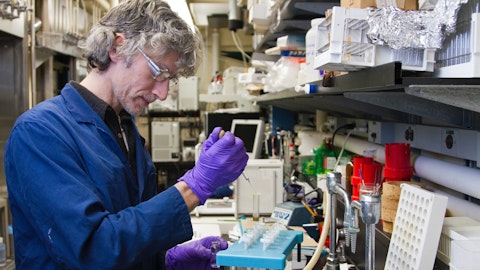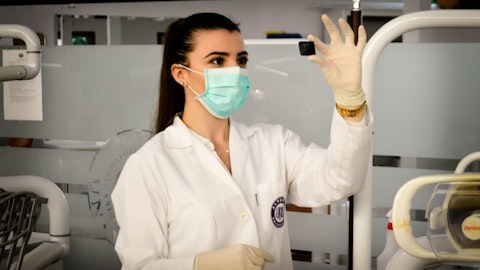Kate Haviland: Yeah Eun, this is Kate. So when we were talking about the Q2 results one of the things — because it was such a stub quarter we had just gotten approved. We only had a few weeks of launch under our belt. What we did is provide — try to help provide a little bit of framework and kind of qualitative discussion around what we were seeing in July because of that we won’t really comment on once we — now we’re in a study — in a place where we’ve seen four quarters of launch, we’re not going to really comment on kind of quarter — the next quarter’s launch. We do look forward to providing guidance on the Q4 call here which is going to be in short order that will be inclusive of ISM for all of 2024. And so I think as Philina said, we can expect that continued kind of strong and steady growth. We’re really pleased about where we are and all of the signs we’re seeing in the marketplace lead to your point to continued strong and steady growth.
Operator: Our next question comes from Brad Canino with Stifel. Your line is open.
Brad Canino: Thank you. And congrats on the great quarter, maybe first just a quick spin on Eun’s question, can you comment on how many patients were added specifically in September. But then more broadly as you plan to provide AYVAKIT guidance in February, what elements of your thinking or assumptions behind your forecast will be most important as you watch the commercial metrics evolve over the next three months? Thank you.
Kate Haviland: Yeah. I’ll just take the first piece because that’s AYVAKIT Brad no, we will not break out kind of patient numbers by month. We’ll continue to report them on a quarterly basis. And then maybe Philina do you want to talk about how you’re thinking about the most important drivers for revenue growth in 2024?
Lena Lee: Yeah. Thanks Brad for the question. I mean some of the key leading indicators that we’ve emphasized on this call that we see is most important for signaling continued growth, include the number of patients on therapy which we see as a strong predictor of continued revenue, given the potential of these patients to remain on therapy for chronic durations. In addition, to the new patient starts that we expect to continue to drive by increasing both the breadth and the depth of prescribing across our prescriber base.
Operator: Our next question comes from Reni Benjamin with JMP Securities. Your line is open.
Reni Benjamin: Hey good morning everyone. Thanks very much for taking the questions and congratulations on a great quarter. Maybe can you talk a little bit about the penetration in into Alegists versus hemoc kind of how many new physicians have you called. On the 250 patients that were added, I think you’ve been asked this multiple times, so I’m going to try it a different way. How many ISM versus SM and would we expect a similar think about Europe and the ultimate approval in Europe should we be thinking about a civil trajectory early on?
Kate Haviland: Thank you so much for the question, Reni. We — you broke up a little bit there at the end but I think it’s really a question around the patients we added and how can we think about the breakdown between different parts of SM advanced versus ISM. And as we’ve mentioned before that’s very hard to tease out because of the common diagnosis code but I’ll certainly let Philina continue to provide details there. I also think you asked a little bit about European approval and then how do you think about the breadth and depth of prescribing. So maybe Philina, if you could take those.
Lena Lee: Yes. Thanks for the question. So of the 200 patients, I mean, I think the bottom line is the inflection point that we’ve seen in this past quarter is primarily driven by ISM. We can see that by the vast majority of patients who have started on the 25-milligram dose. To your question on the prescriber base we are really pleased with the mix of prescriber base that we’re seeing. We saw that big step-up in the number of new prescribers that and importantly, that occurred among, a, the allergists who are important because they tend to see a greater concentration of ISM patients. And secondly, agnostic of specialty we’re seeing that penetration into new prescribers who are just seeing really the deepest — the biggest concentration of SM patients, who have the biggest potential to deepen over time. So in sum, we see a really healthy mix in terms of our prescriber base as well as headroom to continue to grow on that breadth and depth.
Kate Haviland: And then just to comment on the EU approval. Christie, do you want talk about where we are with that one?
Christy Rossi: Sure. So we are looking forward to approval in Europe. That review is on track. And I think Reni your question was kind of higher level regarding the opportunity and how we see it unfolding in the US versus Europe? And what I would say is, I think what the US experience has shown us at this point is that these patients are there. The unmet need is significant. The receptivity to the profile has been incredibly positive. And AYVAKIT is really transforming patient lives. And there’s — we expect to see very similar trends as we launch globally. As Philina said, the dynamics that we see in the US alone based on the market as it sits today get AYVAKIT to a blockbuster status. And so we see opportunity to continue to expand that through geographic launches by growing the market in the US, et cetera. But the bottom line is this opportunity is unfolding exactly as we had expected and we are well on our way to making AYVAKIT blockbuster in SM.
Operator: Our next question comes from Salveen Richter with Goldman Sachs. Your line is open.
Salveen Richter: Good morning. Thanks for taking my question. Maybe pivoting here to ASH. As we look to the 263 data, could you help us understand exactly what will be presented and your view here on what would be a competitive profile in the context of AYVAKIT but also competitors? Thank you.
Kate Haviland: So, thank you Salveen. As Christie really laid out is elenestinib is positioned to help us maximize the long-term performance of our SM franchise. AYVAKIT is really meeting the broad medical needs across the spectrum of SM. And so the solution for those patients are truly in the market today. But elenestinib is going to have a great space in our portfolio, as we think about building that franchise for 10 years and beyond. And so Becker, do you want to talk about what we’ll be showing at ASH?



